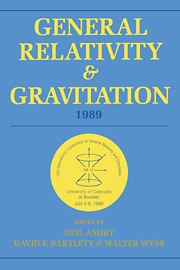 General Relativity and Gravitation, 1989
General Relativity and Gravitation, 1989 Book contents
- Frontmatter
- Contents
- Preface
- Conference committees
- Part A Classical relativity and gravitation theory
- WORKSHOPS
- Part B Relativistic astrophysics, early universe, and classical cosmology
- WORKSHOPS
- B1 Mathematical cosmology
- B2 The early universe
- B3 Relativistic astrophysics
- B4 Astrophysical and observational cosmology
- Part C Experimental gravitation and gravitational wave detection
- WORKSHOPS
- Part D Quantum gravity, superstrings, quantum cosmology
- WORKSHOPS
- Part E Overviews-past, present, and future
B2 - The early universe
Published online by Cambridge University Press: 05 March 2012
- Frontmatter
- Contents
- Preface
- Conference committees
- Part A Classical relativity and gravitation theory
- WORKSHOPS
- Part B Relativistic astrophysics, early universe, and classical cosmology
- WORKSHOPS
- B1 Mathematical cosmology
- B2 The early universe
- B3 Relativistic astrophysics
- B4 Astrophysical and observational cosmology
- Part C Experimental gravitation and gravitational wave detection
- WORKSHOPS
- Part D Quantum gravity, superstrings, quantum cosmology
- WORKSHOPS
- Part E Overviews-past, present, and future
Summary
The hot big-bang cosmology is based upon the Friedmann-Robertson-Walker (FRW) solution of general relativity. It is a remarkably successful model, providing a reliable and tested accounting of the history of the universe from about 10-2 sec after the bang until today, some 15 Gyr later. It is so successful that it is known as the standard model of cosmology. It accommodates—and in some instances explains—most of the salient features of the observed universe, including the Hubble expansion, the 2.74 K cosmic microwave background radiation (CMBR), the abundance of the light elements D, 3He, 4He, and 7Li, and the existence of structures likes galaxies, clusters of galaxies, etc. In the splendor of its success, it has elevated our thinking about the evolution of the universe, and we have been able to ask a new set of even more profound questions about the universe. These questions include: What is the origin of the baryon number of the universe? What is the origin of the primeval inhomogeneities that gave rise to the structure we see today? Why is the part of the universe we can see (our present Hubble volume) so isotropic and homogeneous—as evidenced by the uniformity of the CMBR temperature—and spatially flat? What is the structure of the universe beyond our Hubble volume? What is the nature of the ubiquitious dark matter? Are there other significant cosmological relics to be discovered? Why is the cosmological constant (equivalently the present vacuum energy density) so small compared to its natural scale: ∧ ≲ 10-122G-1?
- Type
- Chapter
- Information
- General Relativity and Gravitation, 1989Proceedings of the 12th International Conference on General Relativity and Gravitation, pp. 247 - 252Publisher: Cambridge University PressPrint publication year: 1990
- 8
- Cited by


